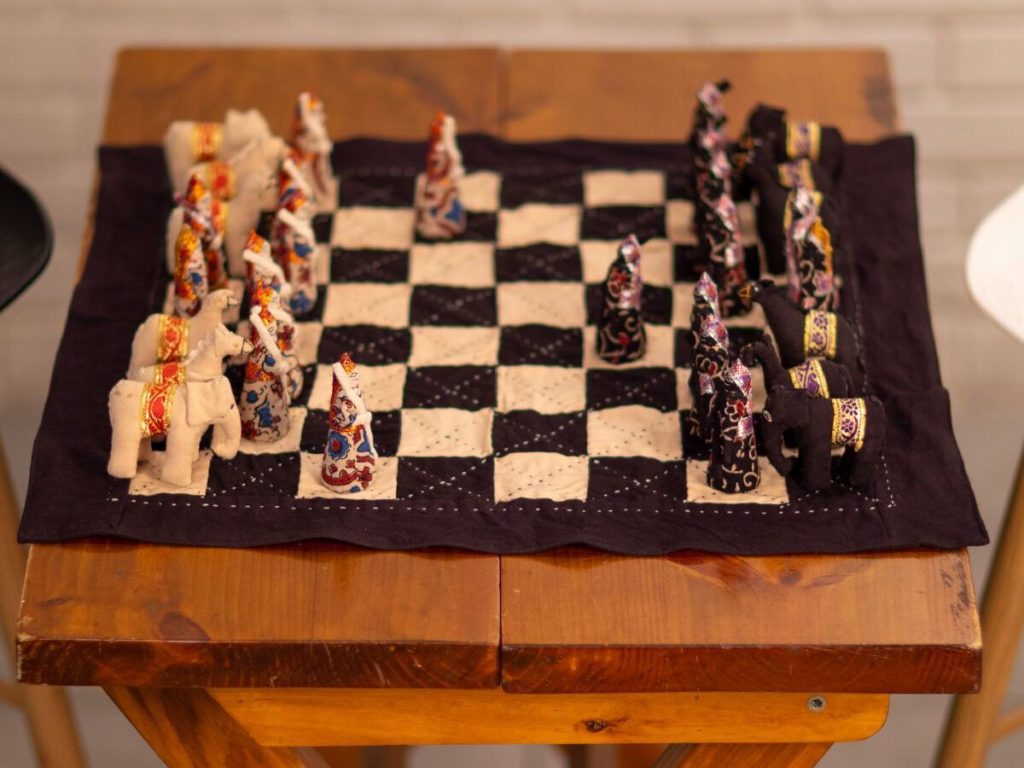Rediscovering India’s timeless board games: a divine journey through history and culture

Prepend to the content

Board games have been an integral part of Indian culture for centuries, serving not only as sources of entertainment but also as reflections of societal values, strategic thinking, and spiritual beliefs. From the ancient game of Chaturanga to the beloved Chaupar, these games have traversed through time, leaving behind a rich tapestry of tradition and heritage.
Games like Pachisi, Chaturanga, Backgammon, and Gyan Chaupar were really important in the courts of different places in India. They were so popular that even kings and queens from other countries wanted them. For example, there’s a story about Indian ambassadors giving the game chaturanga to Khusrow I, who was the King of Persia. This story is written down in Persian books.
Long ago, during the time of the Indus Valley Civilisation, there are signs that people played board games, but we’re not exactly sure how they played or what rules they followed.
It’s also clear that gambling was really common during the Vedic period in India. There are hymns in the Rig Veda, one of the oldest texts in Hinduism, that talk about gambling. One of the most famous hymns is called the ‘Gamester’s Lament’.
Pachisi: The Game of Kings and Destiny
Pachisi is an old game from India, also called Twenty-Five. It goes way back to the time of the Gupta Empire. In this game, you move pieces around a board shaped like a cross. The goal is to capture your opponent’s pieces while keeping yours safe. Pachisi needs both thinking and luck, so it’s loved by both kings and regular people. In Indian stories, Lord Rama is linked to Pachisi. In the Ramayana, it’s said he played Pachisi during his exile. Connecting the game with gods shows how important it is in Indian culture. It’s seen as a way to understand how the universe works and how destiny unfolds.
In the Fatehpur Sikri complex, built by Akbar in the 16th century, there’s a special place called the Pachisi Courtyard. It’s a big outdoor area, kind of hidden between a fort and a garden. Not many tourists notice it because the engravings on the ground are fading away.
Long ago, during festivals, people used this courtyard as a huge game board for playing pachisi. There’s a story that says women in colorful clothes acted like game pieces, jumping from one square to another as the ruler rolled the dice from the middle.
Backgammon: A Game of Strategy and Skill
Backgammon, known as ‘Nard’ in ancient India, is one of the oldest board games still played today. Its origins date back over 5,000 years, with evidence of its existence found in archaeological sites across the subcontinent.
Micaela Soar studied old archaeological evidence and found that backgammon in India began around 400 CE in the Punjab region. It evolved into the familiar game with a 2 x 12 row board.
This game requires strategy and skill as players move their pieces around the board, aiming to remove them before their opponent. Backgammon’s enduring popularity shows its timeless appeal and the lasting importance of strategic gameplay in Indian culture. In Hindu mythology, Lord Shiva, is often linked to strategy and intelligence, reflecting the divine aspect of strategic thinking found in games like backgammon.
Backgammon was depicted in art and culture during its peak popularity, famously shown as the game played by Shiva and Parvati at various temples in the Ellora caves. It’s interesting that backgammon spread from India to Persia by the end of the first millennium. Later, it returned to India as a Persian game during the medieval period, brought by the Mughals and various Sultanates in the Deccan region.
The Divine Play: Board Games in Mythology and Religion
Board games have a special place in Indian mythology and religion, often linked with gods and cosmic stories. In ancient scriptures, we find god’s playing board games, highlighting their spiritual importance. For instance, the game of dice between Lord Shiva and Goddess Parvati represents the balance between destiny and choice in the universe. In a relief from Maihar, Madhya Pradesh, we see Shiva and Parvati playing, with Parvati holding the dice. This theme is significant in western Maharashtra’s cave temples, where such scenes are near the central shrine. Though there was confusion about the game they played, it’s now recognized as backgammon. These myths not only add to India’s rich culture but also show the deeper philosophical meanings of board games in society.
Chaupar: A Game of Royalty and Chance
Chaupar is a game that’s like Pachisi and Ludo. It’s important in Indian stories and traditions. Long ago, during the Mahabharata, the Pandavas and Kauravas played Chaupar while they were away from home. In this game, luck and strategy mix together. Players move their pieces on a board shaped like a cross and use dice to decide what happens next. Chaupar is mentioned in old stories and is still loved by many Indian families today. It shows how important it is in Indian culture, representing unity and friendship. In some religious stories, the god Krishna plays Chaupar with his friends, showing how it’s connected to joy and balance in the universe.
Chaturanga: The Ancestor of Chess
Chaturanga, the early form of chess, came from India around 6th century AD. Its name, meaning “four divisions of the military” in Sanskrit, shows its roots in ancient Indian military strategy. Originally, it was a game to teach young princes about the different parts of the royal army: infantry, elephants, chariots, and cavalry. India first created the game, and then it traveled to West Asia and Europe, where it evolved into modern chess.
In Chaturanga, the pieces represent parts of an army, like infantry or elephants, reflecting the dynamics of real warfare. The transformation of Chaturanga into chess and its popularity worldwide highlight India’s influence on board games and strategic thinking. In religious stories, the god Vishnu, known for his strategic wisdom and balance, is linked with Chaturanga, showing its divine origins and importance.
Gyan Chaupar: The Game of Knowledge and Enlightenment
The game Gyan Chaupar, also known as Snakes and Ladders, has an interesting history. Jain monks are believed to have created it as an educational tool around the early 1000s. Later, it became popular among Hindu and Sufi communities during the Bhakti period when different cultures were blending together. Gyan Chaupar goes beyond just being fun; it teaches moral and spiritual lessons. The board represents life’s journey, with ladders representing good qualities that lift us up and snakes representing bad qualities that bring us down. Originating from ancient India, it was used to teach morals and spiritual ideas. Today, it reminds us of the wise teachings in Indian culture and the importance of self-improvement. In religious stories, Ganesha, the god of wisdom, is often seen playing Gyan Chaupar, emphasizing the quest for knowledge and enlightenment.
The game of snakes and ladders is actually the British version of the old Indian game, Gyan Chaupar, which has many different versions across India and Nepal. In a typical game, players move across labeled boxes representing different states of being, with snakes punishing players for vices and ladders rewarding virtues.
These board games all share a common goal of teaching moral lessons. Gyan Chaupar particularly reflects the complex systems of karmic classification in Vaishnava or Jain philosophy, as players progress from lower to higher states of being. Similarly, Bhakti literature often uses the metaphor of board games to illustrate life’s challenges and solutions. For example, in a Kabir hymn, the Chaupar game symbolizes the confusing world, with the divine guru as the guide out of confusion.
Throughout Indian literature, board games like Chaupar are used as metaphors for life’s journey, highlighting their importance in cultural memory and everyday life.
Board games have moved through different places and times, showing a story from history. They help us learn about religion, ideas, and how power changed in Asia and Europe. Because they’re important, it’s a good idea to make a project about their history. We hope that in the future, people who study art will look more at these old Indian games. They’re important for understanding our past.
The post Rediscovering India’s timeless board games: a divine journey through history and culture appeared first on G2G News.



